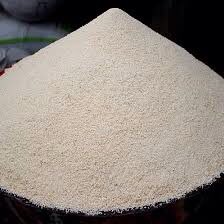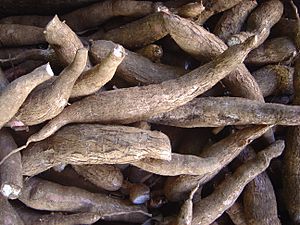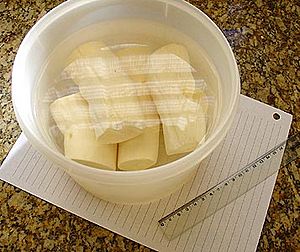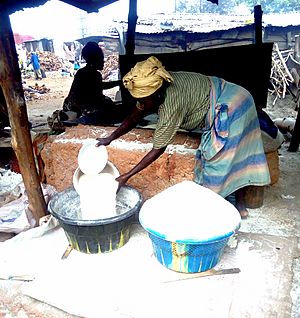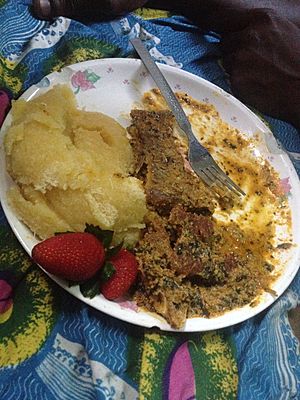Garri facts for kids

Garri (also spelled gari) is a popular food in West Africa. It is a creamy, grainy flour made from the starchy roots of the cassava plant. People also call it galli or gali. All these names mean the same product.
In the Hausa language, 'garri' can also mean flour made from other plants. These include guinea corn, maize, rice, yam, plantain, and millet. For example, garin dawa is from guinea corn. Garin masara comes from maize, and garin alkama from wheat.
Flour-based foods are a big part of the diet in many West African countries. These include Nigeria, Benin, Togo, Ghana, Guinea, Cameroon, and Liberia. People mix these flours with cold or hot water to eat them.
In Northeast Brazil, there is a similar cassava flour called farofa. It is used in many dishes, especially in the state of Bahia.
Contents
How Garri is Made
Making garri flour starts with cassava roots. First, workers peel and wash the tubers. Then, they grate or crush them into a soft mash.
Sometimes, the mash is mixed with palm oil. It is then put into a special bag. This bag goes into a press machine for 1 to 3 hours. This step removes extra water from the mash.
After drying, the mash is sieved. Then, it is fried in a large clay pot. Some people add palm oil during frying, others do not. The result is dry, grainy garri. This can be stored for a long time. It can also be ground into a finer flour.
Delicious Garri Dishes
Garri is used to make many tasty meals and snacks. It comes in different textures: rough, medium, and smooth. Each type is best for certain foods.
Eba: A Staple Meal
Eba is a thick dough made from garri. You make it by soaking garri in hot water. Then, you knead it with a wooden stick until it is smooth. Eba is often served with different soups and sauces. Popular choices include okra soup, egusi soup, and vegetable soup.
Kokoro: A Crunchy Snack
Kokoro is a common snack in Nigeria. It is especially popular in the southern and southeastern parts. To make kokoro, maize flour is mixed with garri and sugar. This paste is then deep-fried until it is crispy.
Garri as a Snack or Cereal
You can enjoy garri as a quick snack or light meal. Just soak it in cold water. It will settle at the bottom of the bowl. Many people add sugar or honey to it. Sometimes, roasted peanuts or evaporated milk are also added. About three parts water to one part garri is a good ratio. You can also eat dry garri with sugar and roasted peanuts.
Garri with Beans
Dry garri is often eaten with soft-cooked beans and palm oil. In Ghana, this mix is called yoo ke garri or garri-fɔtɔ. Garri-fɔtɔ means garri mixed with a thick tomato sauce. Yoo ke garri is garri with beans, often eaten for lunch. In Nigeria, it is also eaten with bean cake.
Cooked Garri Meals
For a full meal, garri is usually cooked. You add it to hot water and stir it into a stiff paste. This paste is then eaten with various stews. These can be thick vegetable stews, melon seed stews, or peanut stews.
Smooth garri, known as lebu to the Yoruba, can be mixed with pepper and spices. A little warm water and palm oil are added and mixed by hand. This type of garri is often served with fried fish. It is also eaten with frejon on Good Friday.
Different Types of Garri
There are two main types of garri in West Africa: white and yellow. Yellow garri gets its color from palm oil. The oil is added to the cassava mash before it ferments. It can also be made from a special yellow cassava plant. White garri is fried without any palm oil.
Both yellow and white garri are common in Nigeria and Cameroon. A famous type of white garri is garri-Ijebu. This comes from the Yoruba people in the Ijebu Kingdom of Nigeria.
In Ghana, people judge garri by its taste and grain size. Sweeter types with smaller grains are often preferred. However, food sellers like coarser grains. These absorb more water, making more food when soaked. Buyers also look for crispy grains to know if the garri is fresh.
Garri can be eaten without cooking, as a snack. This is called garri soakings. You put it in a bowl, add cold water, sugar, groundnut, and milk. Ijebu-garri, with its fine grains and sour taste, is great for this. In West Africa, people often add coconut chunks, groundnuts, or cashew nuts.
Most garri recipes involve cooking it. You add boiling water and stir to make a stiff paste. This paste, often called Eba, is eaten with soups or stews. Many parts of Africa have a similar cassava dish.
In Liberia, garri is used to make a dessert called kanyan. It is mixed with peanuts and honey.
Nutritional Benefits
Cassava, the root used to make garri, is good for you. It is rich in fiber, copper, and magnesium. These nutrients are important for a healthy body.
See also
 In Spanish: Garri para niños
In Spanish: Garri para niños


